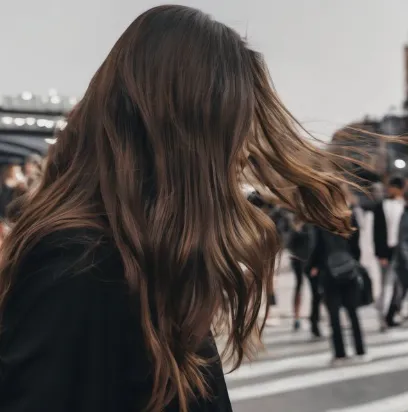
Do you dream of luscious, flowing locks that turn heads? AChieving strong, shiny hair isn’t just a dream; it’s a reality within reach. By understanding your hair’s unique needs and following a personalized hair care routine, you can unlock your hair’s full potential. In this comprehensive guide, we’ll delve into the secrets of how to get strong and shiny hair, from identifying your hair type to protecting it from environmental stressors.
Identifying Your Hair Type and Concerns
The first step to achieving healthy, beatiful hair is understanding your hair type. This knowledge will help you tailor your hair care routine to your specific needs. Here are the most common hair types:
Straight Hair: Straight hair is typically smooth and easy to manage. However, it can become oily quickly, so its important to choose products that control oiliness without stripping away moisture.
Wavy Hair: Wavy hair has a natural bend or curve. It can be prone to frizz, so using products that add moisture and define curls is essential.
Curly Hair: Curly hair is characterized by its tight coils or loose waves. It’s often dry and fragile, so it requires gentle handling and products that provide deep hydration.
Coily Hair: Coily hair is extremely curly and tightly coiled. It’s the most fragile hair type, so it needs extra care and moisture.
Once you’ve identified your hair type, it’s time to assess your hair’s concerns. Common hair problems include:
Dryness: Dry hair lacks moisture and can become brittle and prone to breakage.
Oily Hair: Oily hair produces excess sebum, leading to greasy roots and a lackluster appearance.
Frizz: Frizz occurs when the hair cuticle is raised, causing the hair to appear frizzy and unruly.
Hair Loss: Hair loss can be caused by various various factors, including hormonal imbalances, stress, and poor hair care practices.
By understanding your hair type and addressing your specific concerns, you can create a personalized hair care routine that will help you achieve your hair goals.
Tailoring you’re Hair Wash Routine for Optimal Results
Your hair wash routine plays a crucial role in maintaining healthy, shiny hair. HEre are some tips for creating an effective hair wash routine:
Choose the Right Shampoo: Select a shampoo that is specifically formulated for your hair type and concerns. Avoid harsh sulfates, as they can strip away natural oils and damage your hair.
Condition Properly: Conditioning helps to hydrate and nourish your hair, making it more manageable and less prone to breakage. Apply conditioner from mid-length to ends, avoiding the roots.
The Right Water Temperature: Avoid using hot water, as it can strip away natural oils and damage your hair. Opt for lukewarm or cool water instead.
How Often to Wash Your Hair: The frequency of hair washing depends on your hair type and lifestyle. As a general rule, aim to wash your hair every 2-3 days.
The Power of a Scalp Massage: Massaging your scalp during shampooing can stimulate blood flow, promote hair growth, and relieve stress.
The Art of Conditioning: Hydrating and Nourishing Your Hair
Conditioning is an essential step in any hair care routine. It helps to hydrate and nourish your hair, making it more manageable and less prone to breakage. Here are some tips for effective conditioning:
Deep Conditioning: Deep conditioning treatments can help to restore moisture to dry, damaged hair. Apply a deep conditioner to your hair, leave it on for 15-20 minutes, and then rinse thoroughly.
Leave-In Conditioner: A leave-in conditioner can help to protect your hair from heat styling and environmental damage. Apply a small amount of leave-in conditioner to damp hair, focusing on the ends.
Hair Masks: Hair masks can provide intense hydration and nourishment. Apply a hair mask to your hair once a week, leave it on for 20-30 minutes, and then rinse thoroughly.
Heat Styling Tips to Minimize Damage
Heat styling tools can damage your hair if used excessively. Here are some tips for minimizing heat damage:
Use Heat Protectant: Always apply a heat protectant to your hair before using hot styling tools. This will help to shield your hair from heat damage.
Lower Heat Settings: Use teh lowest heat setting possible on your styling tools.
Limit Heat Styling: Try to limit the use of heat styling tools to special occasions.
Air-Dry Whenever Possible: Air-drying your hair is the gentlest way to style it.
Protecting Your Hair from Environmental Stressors
Environmental factors such as pollution, sun exposure, and wind can damage your hair. Here are some tips for protecting your hair from environmental stressors:
Wear a Hat: Wearing a hat can protect your hair from the sun’s harmful rays and wind damage.
Use Hair Products with UV Protection: Look for hair products that contain UV protection to shield your hair from the sun’s rays.
Avoid Chlorine: Chlorine can damage your hair, so it’s important to protect your hair when swimming in chlorinated water. You can use a swim cap or apply a leave-in conditioner to your hair before swimming.
By following these tips, you can achieve strong, shiny hair that you’ll be proud to show off. Remember, consistency is key. Stick to your hair care routine and be patient. With time and effort, you’ll see a significant improvement in the health and appearance of your hair.